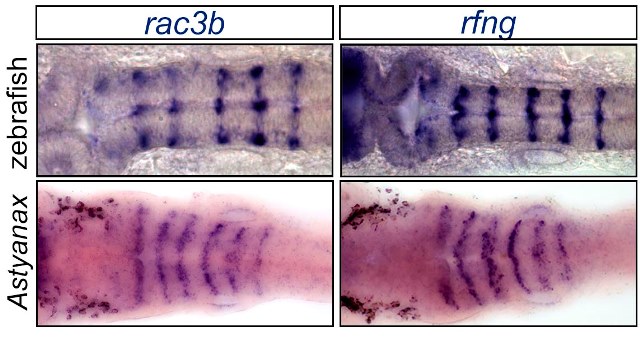The evolutionary origin of a key mechanism in the embryonic development of the brain discovered
The evolutionary origin of a key mechanism in the embryonic development of the brain discovered
A new study reveals the evolutionary origin of the system that segregates neuronal progenitors during the development of the central nervous system in a group of fish. The study, published in PNAS, was co-led by Cristina Pujades, a researcher at Pompeu Fabra University, and Juan Ramón Martínez, a researcher at the Andalusian Center for Developmental Biology.

The evolution of the complexity of organisms and the diversity of species depends on the emergence of novel gene functions. However, evolution rarely produces novelties from scratch but works on preexisting activities. A study co-led by the Research Group Developmental Biology at UPF and the Andalusian Center for Developmental Biology (CABD-CSIC) demonstrates the first evidence of how the rearrangement of conserved gene regulatory elements can generate new developmental mechanisms based on ecological adaptations.
Mechanical actomyosin boundaries
In vertebrates, the central nervous system is formed from an embryonic structure that divides into three vesicles of the brain and the spinal cord. The hindbrain is the most posterior brain vesicle, which is in charge of such important functions as breathing or controlling heart rate. During embryonic development the hindbrain divides into seven segments called rhombomeres, where neuronal progenitors are generated that will give rise to neurons with specific functions.
“In a previous study we showed that there were actomyosin cables at the boundaries between rhombomeres that act as mechanical barriers allowing different neural lineages to remain segregated”, says Cristina Pujades, principal investigator at the Department of Experimental and Health Sciences (DCEXS) at UPF and co-author of the research.
Evolutionary origin
In this new study, published in the journal PNAS, the evolutionary origin of this system of cell segregation has been discovered. “We found that the emergence, over 200 million years ago, of chromosome rearrangement in a large family of freshwater fish resulted in the reuse of a group of genes (rac3b/rfng/sgca) for this system of segmentation of the hindbrain”, explain Pujades and Martinez-Morales.
They combined functional biological studies with functional genomic analysis and genomic editing in zebrafish to demonstrate that genes in cluster rac3b/rfng/sgca are specifically expressed at rhombomeric boundaries through the establishment of new interactions of regulatory elements using a chromosomal rearrangement.
“Our data suggest that the accelerated embryo development observed in this group of fish —the embryos of zebra fish hatch in as little as 48 hours— may have promoted the emergence of new genetic programmes in the hindbrain, and that shows the importance of chromosomal organization for the development of specific biological functions”, conclude the researchers Javier Tramacastilla, Ivan Belzunce and Adrià Voltes, of Cristina Pujades’s group.
This study also involved scientists from the Paris-Saclay Institute of Neuroscience and Pablo de Olavide University.
Reference article:
Letelier, J, Terriente, J, Belzunce, I, Voltes, A, Undurraga, C, Polvillo, R, Devos, L, Tena, J, Maeso, I, Retaux, S, Gomez-Skarmeta, JL, Martinez-Morales, JR, Pujades, C. The evolutionary emergence of the rac3b/rfng/sgca regulatory cluster refined mechanisms for hindbrain boundaries formation. PNAS, March 2018.
